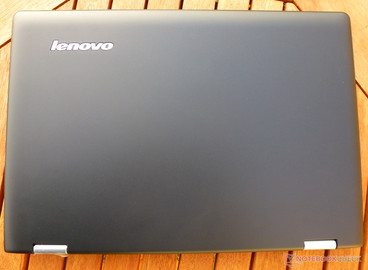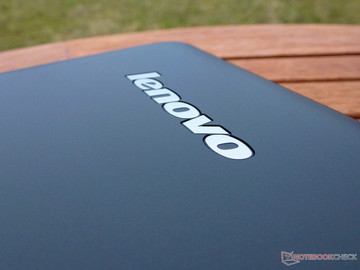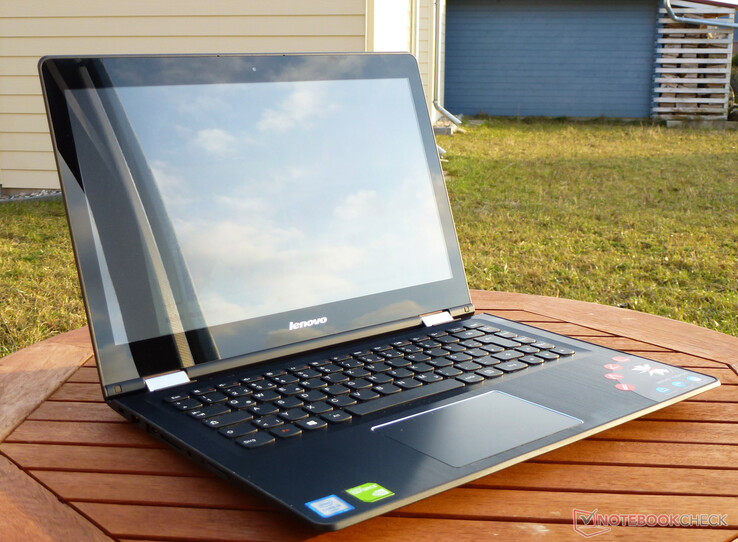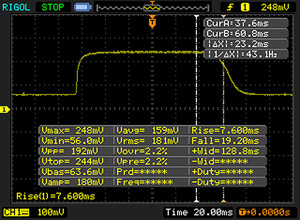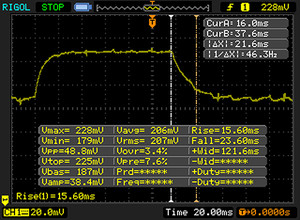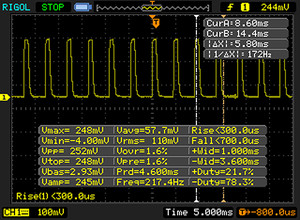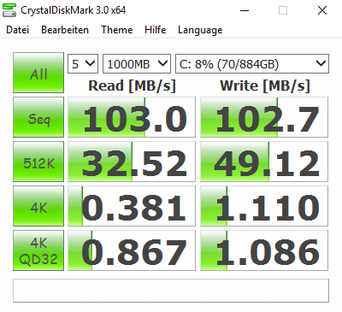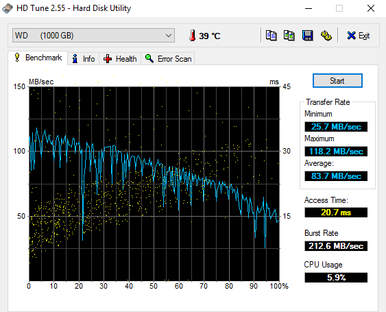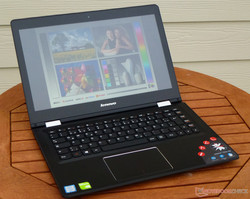Breve análisis del Lenovo Yoga 500-14ISK
Top 10 Análisis
» Top 10 Portátiles Multimedia
» Top 10 Portátiles de Juego
» Top 10 Portátiles de Juego ligeros
» Top 10 Portátiles Asequibles de Oficina/Empresa
» Top 10 Portátiles de Juego Ligeros
» Top 10 Portátiles de Oficina/Empresa Premium
» Top 10 Estaciones de Trabajo
» Top 10 Subportátiles
» Top 10 Ultrabooks
» Top 10 Convertibles
» Top 10 Tablets
» Top 10 Tablets Windows
» Top 10 Tablets de menos de 250 Euros
» Top 10 Phablets (>5.5")
» Top 10 Smartphones
» Top 10 Smartphones (≤5")
» Top 10 Smartphones de menos de 300 Euros
» Top 10 Smartphones de menos de 120 Euros
» Top 10 Portátiles de menos de 1000 Euros
» Top 10 Portátiles de menos de 500 Euros
» Top 10 Portátiles de menos de 300 Euros
» Los Mejores Displays de Portátiles Analizados por Notebookcheck
| |||||||||||||||||||||||||
iluminación: 82 %
Brillo con batería: 234 cd/m²
Contraste: 1064:1 (Negro: 0.22 cd/m²)
ΔE ColorChecker Calman: 6.3 | ∀{0.5-29.43 Ø4.78}
ΔE Greyscale Calman: 5.59 | ∀{0.09-98 Ø5}
39% AdobeRGB 1998 (Argyll 1.6.3 3D)
42.75% AdobeRGB 1998 (Argyll 3D)
61.3% sRGB (Argyll 3D)
41.31% Display P3 (Argyll 3D)
Gamma: 2.53
CCT: 7064 K
| Lenovo Yoga 500-14ISK GeForce 920M, 6200U, WDC Slim WD10SPCX-24HWST1 | Toshiba Satellite Radius 14 L40W-C-10Z HD Graphics 5500, 5015U, HGST Travelstar 5K1000 HTS541010A9E680 | Lenovo Yoga 500-15IBD GeForce 940M, 5200U, WDC Scorpio Blue WD10JPVX-22JC3T0 | HP Envy 15-w000ng x360 GeForce 930M, 5200U, Hitachi Travelstar Z5K500 HTS545050A7E680 | Microsoft Surface Pro 4, Core i5, 128GB HD Graphics 520, 6300U, Samsung MZFLV128 NVMe | |
|---|---|---|---|---|---|
| Display | -8% | -5% | -13% | 57% | |
| Display P3 Coverage (%) | 41.31 | 38.01 -8% | 39.36 -5% | 35.87 -13% | 65 57% |
| sRGB Coverage (%) | 61.3 | 57.2 -7% | 59 -4% | 54 -12% | 96.5 57% |
| AdobeRGB 1998 Coverage (%) | 42.75 | 39.28 -8% | 40.68 -5% | 37.06 -13% | 67 57% |
| Response Times | -7% | -24% | |||
| Response Time Grey 50% / Grey 80% * (ms) | 36 ? | 38 ? -6% | 46 ? -28% | ||
| Response Time Black / White * (ms) | 26 ? | 28 ? -8% | 31.2 ? -20% | ||
| PWM Frequency (Hz) | 217 ? | 2174 ? | 50 ? | ||
| Screen | -37% | -11% | -61% | 32% | |
| Brightness middle (cd/m²) | 234 | 224 -4% | 205 -12% | 183 -22% | 413 76% |
| Brightness (cd/m²) | 209 | 209 0% | 206 -1% | 196 -6% | 396 89% |
| Brightness Distribution (%) | 82 | 84 2% | 87 6% | 82 0% | 87 6% |
| Black Level * (cd/m²) | 0.22 | 0.37 -68% | 0.28 -27% | 0.51 -132% | 0.36 -64% |
| Contrast (:1) | 1064 | 605 -43% | 732 -31% | 359 -66% | 1147 8% |
| Colorchecker dE 2000 * | 6.3 | 10.29 -63% | 6.68 -6% | 12.45 -98% | 3.09 51% |
| Colorchecker dE 2000 max. * | 15.53 | ||||
| Greyscale dE 2000 * | 5.59 | 11.82 -111% | 6.3 -13% | 13.81 -147% | 3.92 30% |
| Gamma | 2.53 87% | 2.56 86% | 2.34 94% | 2.33 94% | 2.3 96% |
| CCT | 7064 92% | 12063 54% | 6996 93% | 16998 38% | 7333 89% |
| Color Space (Percent of AdobeRGB 1998) (%) | 39 | 36 -8% | 37 -5% | 34 -13% | 61 56% |
| Color Space (Percent of sRGB) (%) | 57 | 59 | 54 | 97 | |
| Media total (Programa/Opciones) | -17% /
-26% | -8% /
-9% | -37% /
-47% | 22% /
29% |
* ... más pequeño es mejor
Tiempos de respuesta del display
| ↔ Tiempo de respuesta de Negro a Blanco | ||
|---|---|---|
| 26 ms ... subida ↗ y bajada ↘ combinada | ↗ 719 ms subida | |
| ↘ ms bajada | ||
| La pantalla mostró tiempos de respuesta relativamente lentos en nuestros tests pero podría ser demasiado lenta para los jugones. En comparación, todos los dispositivos de prueba van de ##min### (mínimo) a 240 (máximo) ms. » 61 % de todos los dispositivos son mejores. Eso quiere decir que el tiempo de respuesta es peor que la media (20.2 ms) de todos los dispositivos testados. | ||
| ↔ Tiempo de respuesta 50% Gris a 80% Gris | ||
| 36 ms ... subida ↗ y bajada ↘ combinada | ↗ 15 ms subida | |
| ↘ 21 ms bajada | ||
| La pantalla mostró tiempos de respuesta lentos en nuestros tests y podría ser demasiado lenta para los jugones. En comparación, todos los dispositivos de prueba van de ##min### (mínimo) a 636 (máximo) ms. » 49 % de todos los dispositivos son mejores. Eso quiere decir que el tiempo de respuesta es peor que la media (31.6 ms) de todos los dispositivos testados. | ||
Parpadeo de Pantalla / PWM (Pulse-Width Modulation)
| Parpadeo de Pantalla / PWM detectado | 217 Hz | ≤ 90 % de brillo | |
La retroiluminación del display parpadea a 217 Hz (seguramente usa PWM - Pulse-Width Modulation) a un brillo del 90 % e inferior. Sobre este nivel de brillo no debería darse parpadeo / PWM. La frecuencia de 217 Hz es relativamente baja, por lo que la gente sensible debería ver parpadeos y padecer fatiga visual por la pantalla (usado al brillo indicado a continuación). Comparación: 53 % de todos los dispositivos testados no usaron PWM para atenuar el display. Si se usó, medimos una media de 8125 (mínimo: 5 - máxmo: 343500) Hz. | |||
| Cinebench R10 | |
| Rendering Single CPUs 64Bit (ordenar por valor) | |
| Lenovo Yoga 500-14ISK | |
| Microsoft Surface Pro 4, Core i5, 128GB | |
| Rendering Multiple CPUs 64Bit (ordenar por valor) | |
| Lenovo Yoga 500-14ISK | |
| Microsoft Surface Pro 4, Core i5, 128GB | |
| Shading 64Bit (ordenar por valor) | |
| Lenovo Yoga 500-14ISK | |
| Microsoft Surface Pro 4, Core i5, 128GB | |
| PCMark 8 | |
| Home Score Accelerated v2 (ordenar por valor) | |
| Lenovo Yoga 500-14ISK | |
| Lenovo Yoga 500-15IBD | |
| Microsoft Surface Pro 4, Core i5, 128GB | |
| Creative Score Accelerated v2 (ordenar por valor) | |
| Lenovo Yoga 500-14ISK | |
| Microsoft Surface Pro 4, Core i5, 128GB | |
| Work Score Accelerated v2 (ordenar por valor) | |
| Lenovo Yoga 500-14ISK | |
| Lenovo Yoga 500-15IBD | |
| HP Envy 15-w000ng x360 | |
| Microsoft Surface Pro 4, Core i5, 128GB | |
| PCMark 7 - Score (ordenar por valor) | |
| Lenovo Yoga 500-14ISK | |
| Toshiba Satellite Radius 14 L40W-C-10Z | |
| Lenovo Yoga 500-15IBD | |
| HP Envy 15-w000ng x360 | |
| Microsoft Surface Pro 4, Core i5, 128GB | |
| PCMark 7 Score | 2582 puntos | |
| PCMark 8 Home Score Accelerated v2 | 2689 puntos | |
| PCMark 8 Creative Score Accelerated v2 | 2956 puntos | |
| PCMark 8 Work Score Accelerated v2 | 3585 puntos | |
ayuda | ||
| Lenovo Yoga 500-14ISK GeForce 920M, 6200U, WDC Slim WD10SPCX-24HWST1 | Toshiba Satellite Radius 14 L40W-C-10Z HD Graphics 5500, 5015U, HGST Travelstar 5K1000 HTS541010A9E680 | Lenovo Yoga 500-15IBD GeForce 940M, 5200U, WDC Scorpio Blue WD10JPVX-22JC3T0 | HP Envy 15-w000ng x360 GeForce 930M, 5200U, Hitachi Travelstar Z5K500 HTS545050A7E680 | Microsoft Surface Pro 4, Core i5, 128GB HD Graphics 520, 6300U, Samsung MZFLV128 NVMe | |
|---|---|---|---|---|---|
| CrystalDiskMark 3.0 | -9% | 27% | -42% | 9298% | |
| Read Seq (MB/s) | 103 | 97.1 -6% | 114.4 11% | 63.9 -38% | 666 547% |
| Write Seq (MB/s) | 102.7 | 94.9 -8% | 113 10% | 60 -42% | 154.2 50% |
| Read 512 (MB/s) | 32.52 | 32.3 -1% | 41.87 29% | 20.94 -36% | 266.3 719% |
| Write 512 (MB/s) | 49.12 | 37.5 -24% | 59.7 22% | 23.28 -53% | 154.2 214% |
| Read 4k (MB/s) | 0.381 | 0.39 2% | 0.542 42% | 0.241 -37% | 28.51 7383% |
| Write 4k (MB/s) | 1.11 | 0.958 -14% | 1.211 9% | 0.617 -44% | 101.5 9044% |
| Read 4k QD32 (MB/s) | 0.867 | 0.796 -8% | 1.498 73% | 0.471 -46% | 368.3 42380% |
| Write 4k QD32 (MB/s) | 1.086 | 0.952 -12% | 1.281 18% | 0.623 -43% | 153.6 14044% |
| 3DMark 06 Standard Score | 8808 puntos | |
| 3DMark Vantage P Result | 5518 puntos | |
| 3DMark 11 Performance | 1823 puntos | |
| 3DMark Ice Storm Standard Score | 37066 puntos | |
| 3DMark Cloud Gate Standard Score | 4926 puntos | |
| 3DMark Fire Strike Score | 1045 puntos | |
| 3DMark Fire Strike Extreme Score | 507 puntos | |
ayuda | ||
| bajo | medio | alto | ultra | |
|---|---|---|---|---|
| Thief (2014) | 22.9 | 14.1 | 16.9 | 5.9 |
| GRID: Autosport (2014) | 106.6 | 55.3 | 28.12 | 16.2 |
| F1 2014 (2014) | 96 | 71 | 44 | 26 |
Ruido
| Ocioso |
| 32.8 / 32.8 / 32.8 dB(A) |
| HDD |
| 33.4 dB(A) |
| Carga |
| 39.4 / 39.2 dB(A) |
 | ||
30 dB silencioso 40 dB(A) audible 50 dB(A) ruidosamente alto |
||
min: | ||
(+) La temperatura máxima en la parte superior es de 38.2 °C / 101 F, frente a la media de 35.4 °C / 96 F, que oscila entre 19.6 y 60 °C para la clase Convertible.
(±) El fondo se calienta hasta un máximo de 41.5 °C / 107 F, frente a la media de 36.8 °C / 98 F
(+) En reposo, la temperatura media de la parte superior es de 27.2 °C / 81# F, frente a la media del dispositivo de 30.3 °C / 87 F.
(+) El reposamanos y el panel táctil están a una temperatura inferior a la de la piel, con un máximo de 30.2 °C / 86.4 F y, por tanto, son fríos al tacto.
(-) La temperatura media de la zona del reposamanos de dispositivos similares fue de 27.9 °C / 82.2 F (-2.3 °C / -4.2 F).
| Lenovo Yoga 500-14ISK GeForce 920M, 6200U, WDC Slim WD10SPCX-24HWST1 | Toshiba Satellite Radius 14 L40W-C-10Z HD Graphics 5500, 5015U, HGST Travelstar 5K1000 HTS541010A9E680 | Lenovo Yoga 500-15IBD GeForce 940M, 5200U, WDC Scorpio Blue WD10JPVX-22JC3T0 | HP Envy 15-w000ng x360 GeForce 930M, 5200U, Hitachi Travelstar Z5K500 HTS545050A7E680 | Microsoft Surface Pro 4, Core i5, 128GB HD Graphics 520, 6300U, Samsung MZFLV128 NVMe | |
|---|---|---|---|---|---|
| Power Consumption | 31% | 16% | 26% | 29% | |
| Idle Minimum * (Watt) | 6.6 | 4.7 29% | 4.2 36% | 3.3 50% | 4.4 33% |
| Idle Average * (Watt) | 10.6 | 6.9 35% | 7.4 30% | 6 43% | 9 15% |
| Idle Maximum * (Watt) | 10.8 | 7.2 33% | 8.6 20% | 7.8 28% | 10.7 1% |
| Load Average * (Watt) | 37 | 26.8 28% | 36.5 1% | 30.3 18% | 19.6 47% |
| Load Maximum * (Watt) | 39 | 26.6 32% | 42.7 -9% | 42.3 -8% | 19.9 49% |
* ... más pequeño es mejor
| Off / Standby | |
| Ocioso | |
| Carga |
|
Clave:
min: | |
Pro
Contra
El Lenovo Yoga 500-14ISK es un sólido convertible de 14" para múltiples escenarios de uso. Si estás buscando un convertible, probablemente sepas cómo lo vas a usar. Nabegar cómodamente en el modo tablet o atril en el sofá y reproducir vídeo en el modo tienda son sólo un par de escenarios de uso. El dispositivo de 14" es algo más ligero que dispositivos de 15" comparables, pero pesa 1.8 kg. Si eso es demasiado pesado es una impersión subjetiva. Pero no deberías centrarte demasiado en el peso si el modo tablet no es tu uso principal. Lenovo hace bien muchas cosas. Los materiales causan una impresión sofisticada y las bisagras de 360º funcionan muy bien. No hay nada que criticar de teclado, ClickPad o pantalla táctil. Otro aspecto positivo es el uso del panel FHD IPS. Ofrece amplios ángulos de visión, buen contraste y un buen valor de negro. El único problema es el rendimiento en exteriores, ya que la luz del sol es un problema debido al bajo brillo combinado con la lustrosísima pantalla.
También hay ciertas cosas que criticar. Nos habría gustado ver un SSD, lo que habría aumentado la productividad. Por desgracia, Lenovo sólo ofrece un HDD. Hay bastante espacio de almacenamiento con una capacidad de 1 TB. Otro problema es la batería. si te preocupa el aguante, deberías mirar bien, porque menos de 3 horas en nuestro test Wi-Fi es algo decepcionante. El precio del Lenovo Yoga 500-14ISK con la Nvidia GeForce 920M es de769 Euros. Esto es comparable con los rivales. El rendimiento de juego no es del todo bueno. A los entusiastas del juego les irá mejor con un chip GTX. La GPU más potente para un convertible es actualmente la Nvidia GeForce 940M.
El Yoga 500-14ISK podría ser un todoterreno genial si Lenovo hubiera usado una batería más grande y un SSD. Un buen display IPS, una GPU dedicada y un veloz procesador no lo son todo.
Todavía tenemos que responder a la pregunta de si Lenovo puede competir con la Microsoft Surface Pro 4. Bien, pongámoslo así: Si no estás dispuesto a pagar 1,250 Euros por un tablet y no necesitas un diseño esbelto o buen aguante de batería, el Lenovo puede ser una alternativa.
Ésta es una versión acortada del análisis original. Puedes leer el análisis completo en inglés aquí.
Lenovo Yoga 500-14ISK
- 04/18/2016 v5.1 (old)
Sebastian Bade




